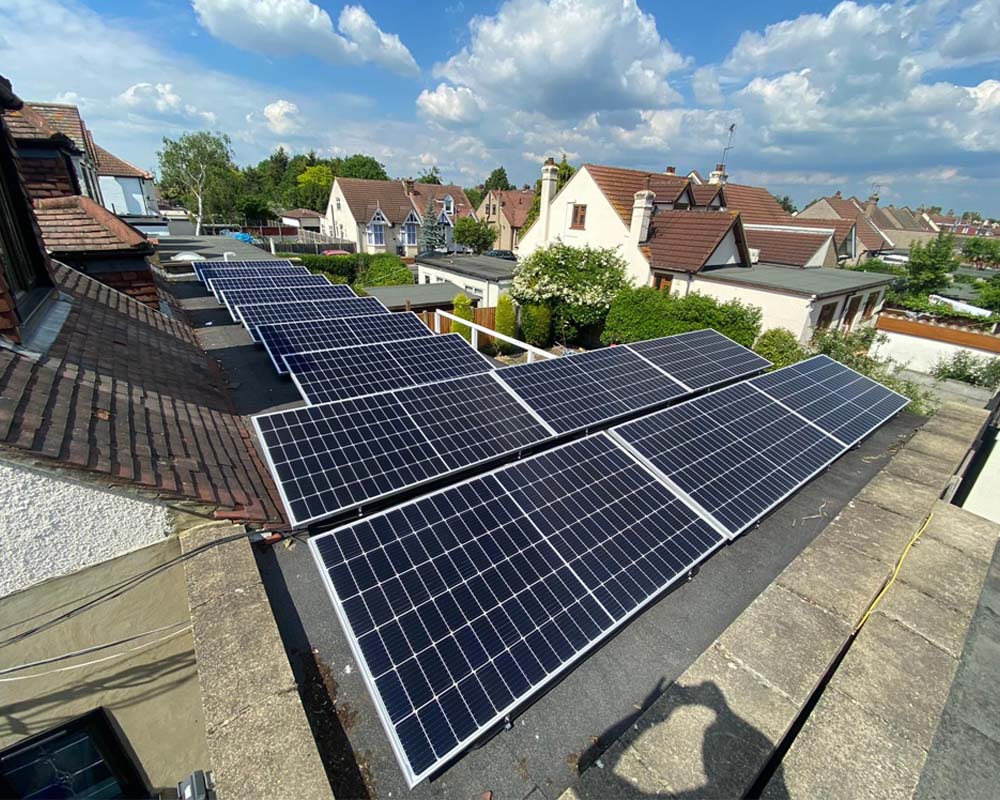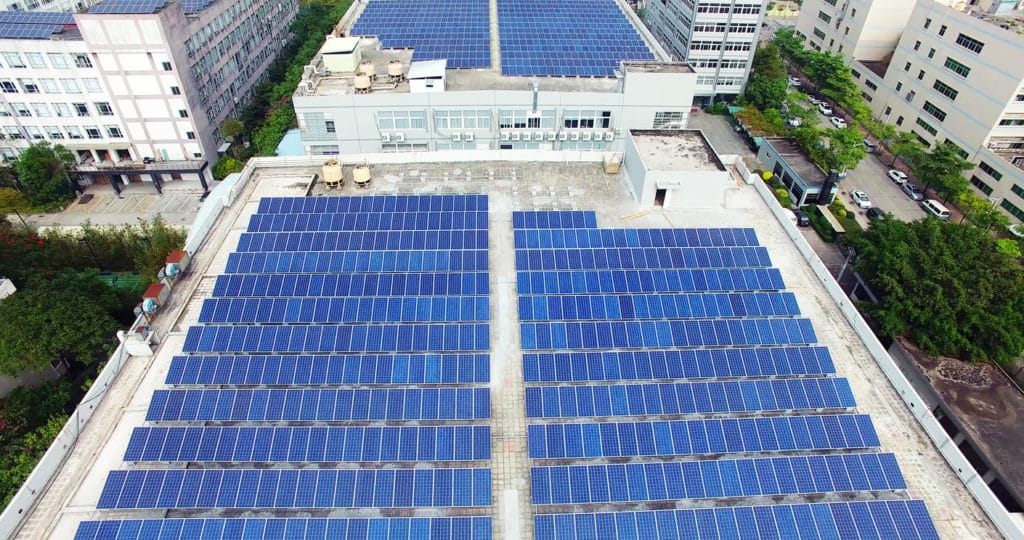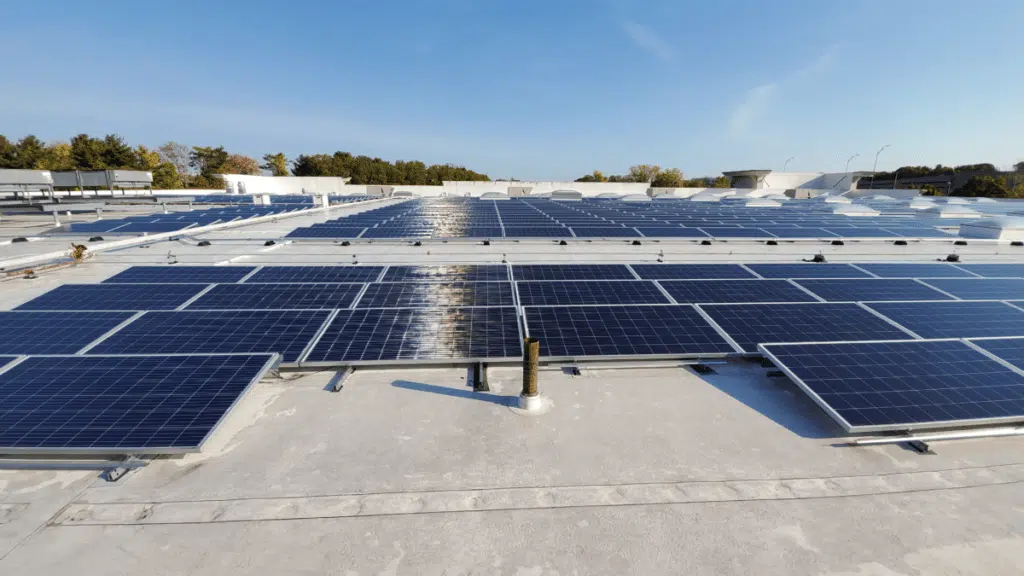
Solar panels may be the smartest investment you’ve ever made to produce energy for a commercial building. Today, in the 21st century, with the increasing global demand for renewable energy, it has become one of the most widely accepted forms of energy production.
Solar panels on flat roofs are no more expensive than a standard pitched roof installation. Our residential flat roof solar systems can be installed flush or angled to fit any residential flat roof solar system design. In fact, a flat roof is the perfect location for solar panels.
In this article, we will have an in-depth understanding of the relevant information about solar panels on flat roof, so that you have an in-depth understanding and understanding of solar panels on flat roofs!
Can Solar Panels be Installed on a Flat Roof?
Sure, you can install solar panels on buildings with flat roofs. Solar panel roof designs are not only effective, but also offer a long list of benefits.
Flat roofs tend to be found on larger commercial buildings. Whether it’s warehouses, manufacturing facilities, or other buildings, these types of buildings tend to consume a lot of electricity. One advantage of using solar energy is that the more electricity these facilities use, the more money owners can save through solar energy.
Many people with flat roofs do not consider solar panels because they believe their roof does not receive enough direct sunlight to install solar panels. Solar energy should be a viable option for every home, business and community. While flat-roof solar systems are more commonly used in commercial buildings, they can of course be installed on homes as well.

Flat Roof Solar Panel Mounting Installation Method
There are three effective ways to install solar panels on your flat commercial roof to avoid roof leaks.
Ballast type mounting
This method of installation is the most efficient and easiest method. This method is ideal in cases where it is not possible to drill holes in the roof, as there is no need to drill and anchor the entire process. It uses a ballast solar panel rack, that is, the use of heavy objects to fix the solar cabinet rack in the appropriate position.
Additional installation
In cases where your roof does not have a storm wall to reduce wind speed, additional installation is the most ideal option. Since the process involves chemical anchoring, this can be the most costly of all types. When additional anchorage force is needed to insert the bolts and secure the panels, resin is used to fill all gaps. In addition, this ensures that it is thoroughly sealed, preventing the building’s internal humidity from rising.
Base mounting or pedestal mounting
This type is especially suitable for flat roofs with high retaining walls. In this case, solid blocks will be used as the concrete foundation, making it look just like a regular ground-mounted system, except that it is installed on a flat commercial roof. This type of shelf is preferred when the building is too old to drill, or when you may make changes to the waterproof roof that affect the insurance.
How Does a Flat Roof Installation System For Solar Panels Work?
When a solar photovoltaic system is installed on a flat roof, it usually follows the slope of the original roof; In contrast, a flat roof system requires a professional installer to set the appropriate tilt Angle. The obvious benefits mean that the design of the system can be tailored to the needs for optimal solar energy use.
Under normal circumstances, the ideal inclination of solar panels is about 30 degrees from the ground. The reason for this is that this Angle allows the panels to receive maximum sunlight at the time of day. For flat roof installation, the above set panel inclination is quite easy to achieve. This is thanks to the fact that the solar panels will be mounted on special brackets, so that the panels can simply maintain a tilt Angle of about 30 degrees.
Flat roof solar panels are typically mounted on top of bathtubs and then compressed with ballast (such as gravel, paving slabs, bricks, rocks, etc.) to withstand the effects of strong winds. In some cases, these panels are mounted directly onto metal frames. Which approach is adopted depends mainly on the structure and location of the building.
Advantages of Flat Roof Installation of Solar Panels
Maximize solar panel output
Whether you are using renewable energy at home or on a commercial scale, this is definitely good news for you. Because when we install solar panels on a sloping roof, solar engineers need to make fine considerations about the tilt Angle of the roof and its orientation. And if the roof is facing east, north or west, the solar panels produce far less electricity than expected.
However, on a flat roof, you can freely adjust the solar panel system to face south and west. You can also make sure it corresponds to the latitude of your location, as this is the ideal location for any solar panel.
Reduce the total cost of installation
About 10% to 15% of the cost of installing solar panels is spent on labor and the installation process. However, flat roofs are cheaper because they are safer, more accessible and do not require additional safety equipment.
Reduce possible risks
The possibility of people or materials falling off the roof during installation is greatly reduced when installed on a flat roof compared to a pitched roof.
Reduce the possibility of wear and tear
In addition to ease of access and lower installation costs, another major advantage of a flat roof is that it can withstand more wear and tear during installation than a pitched roof. This advantage also shows that there is no danger of damaging the roof during installation, unlike the sloping roof, which may cause shingles to fall off.
Maintain the overall beauty of the building
Solar panels on flat roofs are usually not visible from the street. This will help maintain the overall aesthetic value of your home.
Given all these factors, we have every reason to believe that flat roofs are really an ideal choice for installing solar panels. However, we must also be clear that it is not without any shortcomings
Disadvantages of Flat Roof Solar Panels
Compared to solar systems on regular roofs, systems with flat roofs require more space per kilowatt. The reason for this problem is that when setting up solar panels, we need to leave gaps between each row to prevent one installation row from blocking the sunlight of the other row.
Similarly, the decision to install solar panels on a flat roof depends on the structure of your roof. Because the flat roof needs to have enough load-bearing capacity to withstand the additional load brought by equipment such as solar panels.
Factors to Consider When Installing Solar Panels on a Flat Roof
Installing solar panels on flat roofs is not impossible. But before you can do that, you need to address some existential factors to make the installation more secure and reliable.
Investigate the condition of the roof and the potential hazards it may pose to solar panels. Perform any necessary repairs (such as fixing leaks) before proceeding with the installation.
Consider your location and the amount of sunlight your roof receives. If your building towers over your house or covers your roof, then a roof installation will not be the best option for you.
Consider the prevailing weather conditions in your area. High wind speeds, snow, sleet and rain can cause irreparable damage to rooftop solar panels.
Solar Output and Power Generation on The Flat Roof

You may have heard that flat roof solar panels do not produce good results due to the lack of Angle towards the sun or shade from adjacent buildings or trees. In fact, flat roof solar does not have any inherent disadvantages compared to pitched roof systems.
While there may be different design considerations and equipment required, these factors do not affect the quality of the system or energy production. But because flat roof systems require specialized design, it’s best to choose an installer who knows how to maximize the solar performance of these types of roofs.
Do Solar Panels on Flat Roofs Always Need to be Tilted?
Not necessarily, but it is highly recommended that you follow the optimal tilt Angle during installation to maximize the output. The slanted setting also helps with maintenance, as rain can wash away any dust or debris that may have accumulated on the solar panels over time.
The optimum tilt Angle ensures optimal productivity and worry-free maintenance. However, even a slight tilt of three or four degrees can prevent water problems and prevent damage to the roof and solar system.
In addition, panels with a tilt of less than two degrees are often challenging to obtain a warranty due to the high likelihood of damage from water seepage.
Conclusion
Solar panels on a flat roof have some unique advantages and challenges that will not deter you from installing a solar panel system. In terms of design, they provide the ideal environment, including allowing the system to face the sun, reducing installation costs, reducing the risk of injury, and maintaining the beauty of the building.
No matter which direction your house faces, you can control the installation Angle. This will ensure an optimized system for your home or business. This allows solar panels to operate more efficiently on a flat roof.
If you still have any questions or need further assistance, please contact the GYCX Solar experts who have the experience and knowledge to answer your questions. Let us work together towards a greener, more sustainable tomorrow.
GET A QUOTE NOW
Frequently Asked Questions
Can I combine battery storage with a flat roof solar system?
Yes, if you have a flat roof, you can still install a solar + storage system. Discuss your energy storage needs with your installer to see which type of solar + energy storage system is right for your home.
Can I buy solar tiles for my flat roof?
You should not install solar tiles on a flat roof. They’re not efficient, they collect dirt, they collect water. Also, flat roofs don’t usually have shingles, so you won’t get the same aesthetic effect as a pitched roof. We recommend only installing properly installed solar panels on flat roofs.
Will my flat roof solar system produce less energy than a regular solar system?
No, the energy production of a flat-roof solar system should be as good or better than a sloped roof system. Flat roofs often provide greater flexibility in system design. You can control the Angle at which the panels are installed to achieve peak solar power generation, thereby increasing efficiency.
